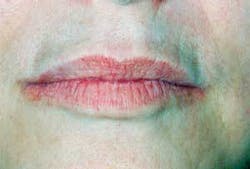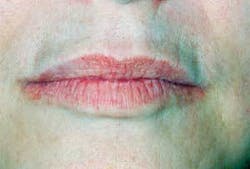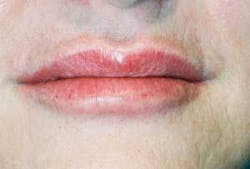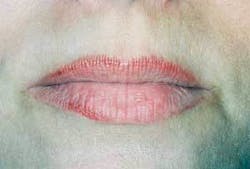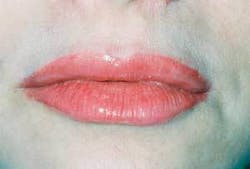Lips, lips, LIPS!
How about expanding dental esthetics? Why not custom frame our dental masterpieces?
WRITTEN BY Simona Cuevas, DDS
As dental practitioners, we believe that when dealing with the anterior esthetics of a patient, we regard the mouth as a stage with the lips as curtains and the teeth as players.
We have learned to observe, diagnose, and correct all possible esthetic scenarios of tooth and tissue misalignments. Yet until now, we have focused only on what’s behind the curtains and not on the forefront - the lips.
Modern developments in materials have allowed us to address a concern that in the past was left to medical practitioners to correct.
The lips
How many times have you completed a beautiful esthetic anterior reconstruction and realized during the final overview that the patient is deficient in the smile with an uneven, wrinkled, or flat lip line?
How many times have you recalled a patient only to observe that he or she had a lip augmentation that came out so uneven and unnatural that it made all your work look like the beautiful background to a disaster in the forefront?
The lips - second only to the eyes - are focal points of the face, and I believe that being able to augment and esthetically correct this area is in our skilled hands as dental surgeons. The lips are part of the mouth, and who would be better trained to augment or change this shape than we who look at them and beyond them daily?
Don’t be scared. We think a 1 millimeter discrepancy is huge. In soft tissue, 1 millimeter is nothing, therefore you are safe.
Considering the basics of your thorough head and neck knowledge, infinite attention to detail, esthetic eye, and professional training, I ask, “Wouldn’t you be better suited to perform this procedure than anyone else?”
Additional augmentation training is offered by manufacturers in the form of detailed, educational brochures depicting proper techniques. Also available is a large variety of CE courses.
Many plastic surgeons’ and dermatologists’ offices allow nurses to treat lip augmentation patients with nonpermanent methods, so why wouldn’t you, the doctor?
There is a variety of nonpermanent fillers available on the market today.
These soft-tissue fillers are comprised of four general categories:
●Fat (autologous)
●Bovine collagen (xenogenic)
●Bioengineered human collagen (allogenic)
●Hyaluronic acid (animal- and nonanimal-based xenogenic)
The most commonly used nonpermanent tissue filler is Restylane®, the name brand for a hyaluronic acid made by Medics Aesthetics, Inc., in Scottsdale, Ariz.
It was introduced to the U.S. market in December 2003 and approved for soft-tissue augmentation in primarily esthetic procedures.
Hyaluronic acid, or hyaluronan, is a glycosaminoglycon that consists of regularly repeating, nonsulfated disaccharide units of glucuronic acid and N-acetylglucosamine. Hyaluronan is a naturally occurring biopolymer that exhibits no species or tissue specificity.
Hyaluronan’s invariance across species is important because it reduces the potential for immunological reactions and implant rejection.
It was first developed as a dermal filler in 1989 by Endre Balzas.
It is important to know that native hyaluronic acid is easily metabolized and must be stabilized through a cross-linked process to produce practical forms suitable for use as skin fillers.
The Restylane product is biocompatible with native hyaluronic acid and exhibits two to three months implant residence time of six months to one year or longer, depending on the amount of additional subsequent corrections called “serial treatments.”
Restylane is a gel of 1.4-butandiol diglycidylether-stabilized, terminally heat-sterilized hyaluronic acid suspended in a physiologic buffer at a pH of 7 and a concentration of 20 mg/ml. The gel is supplied in 1.0 ml or 0.4 ml disposable syringes with Luer-lock fittings. A sterile 30-gauge half-inch needle is supplied with each syringe. A label is part of each Restylane syringe that can be attached to a patient’s record to ensure traceability of the product.
It can be used effectively in patients of all skin types and ethnic origins.
Like all other temporary, soft-tissue fillers, it replenishes the loss of subcutaneous volume.
The augmentation of the lips can include but is not limited to changing the depth of vertical wrinkles, reversing the ptosis of the oral commissures, augmenting the size of the lips, and redefining lip edges and Cupid’s bows.
Dental practitioners are versed in anesthetizing the lips without any difficulty. This knowledge and practice gives dentists an advantage over all other practitioners from three points of view:
➊Patient comfort (no pain)
➋ No bruising resulting from the vaso-constriction effect of epinephrine in anesthetics
➌ Enables doctors to maneuver freely and permits their artistic aptitude to unwrap on nonmobile canvases.
The foremost convenience of nonpermanent fillers is the ability to select the amount of augmentation by adjusting the amount of implantation to fulfill varying ideals of patients’ esthetic requests.
To the right are before and after photos of patients with varying size and augmenta-tion requests. The photos were taken immediately pre- and post-implantation.
References
1 American Society of Plastic Surgeons: Supplement to Plastic and Reconstructive Surgery; Consensus Recommendations for Soft-Tissue Augmentation with Nonanimal Stabilized Hyaluronic Acid (Restylane®) (NASHA); Lippincott Williams & Wilkins; Vol. 117; No. 3; March 2006.
2 Bosniak S, Cantisano-Zilkha M, Glavas IP. Archives of Facial Plastic Surgery; Nonanimal Stabilized Hyaluronic Acid for Lip Augmentation and Facial Rhytid Ablation; JAMA & Archives Journals, AMA; Vol.6; Nov/Dec 2004; pg 379-383.
Simona Cuevas, DDS
Dr. Cuevas is a graduate of the University of Texas Health Science Center, San Antonio. She is head of the Institute of Esthetic Dentistry in San Antonio, where she practices full time. She may be reached via e-mail at [email protected].
